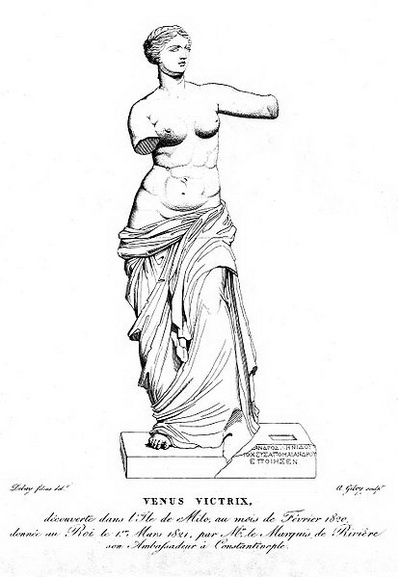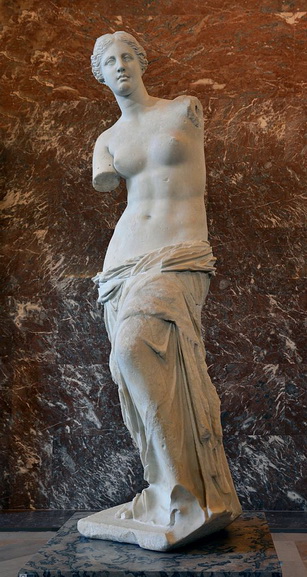[ad_1]
The art made in ancient Greece set the foundations of the artistic practice in terms of careful observations of the human anatomy and naturalistic representation in general. The domains of those artists are mostly preserved as sculpture, and one of the world’s best-known pieces is undoubtedly The Aphrodite of Milos, better known under the name Venus de Milo.
This outstanding armless statue produced between 130 and 100 BC was first attributed to the sculptor Praxiteles; however, the inscription on its plinth indicates that it is the work of Alexandros of Antioch. Although it is commonly believed that this marble sculpture represents the Greek goddess Aphrodite, some scholars argue that it is the sea-goddess Amphitrite, whose cult is spread on the island of Milos.
Throughout the 20th century, Venus de Milo became an ultimate icon of ancient art, which is also related with the fact that the sculpture is located in The Louvre, one of the best-known museums in the world.

The Discovery Of Venus de Milo
In 1820, Venus de Milo was discovered inside a buried niche in the village of Trypiti on the island of Milos, which belonged to the Ottoman Empire then, by an ensign in the French navy, Olivier Voutier, and local peasant Yorgos Kentrotas – although other source suggest that Yorgos Bottonis located the sculpture along with his son Antonio, and there are several other interpretations of the story of the finding of the site.
Namely, while Voutier’s ship was anchored in the harbor at Milos, he decided to spend his time by searching for antiquities. That is when he encountered Kentrotas (or Bottonis) who searched the stones for construction purposes. It was then that Voutier found out that the farmer had found the top half of a statue of a woman, so the two men dug out the work. Voutier reported the discovery to his superiors, so the French acquired the artwork for a modest sum, which later became known as the Venus de Milo. A year later, it arrived in France and was presented to Louis XVIII, who donated it to the Louvre Museum.
However, the conclusion is that the statue was found in two large pieces along with several pillars decorated with heads, as well as fragments of the upper left arm holding an apple, and an inscribed plinth (which was lost during the transport after the discovery).
When it comes to Venus de Milo’s missing limbs, the scholars proposed that they were broken during a fight between French and Turkish sailors on the shore of Milos, before the work was located. Today it is believed that the arms were already missing when Voutier and the farmer founded. Speculation remains about the Venus de Milo’s original pose, although evidence suggests that she once held an apple in its left hand.
3D Reconstruction of Venus de Milo
The Location
During the Paris Commune riot In 1871, numerous public buildings were exposed to fires, but the Venus de Milo statue survived since it was sealed in an oak crate by the Louvre Museum and hidden in the basement of the Police precinct; that building was burned, but the statue remained undamaged. American sculptor Robert Ingersoll Aitken created quite a stir in 1920 by criticizing the display of the sculpture in the museum. In the threat of war in 1939, Venus was packed and sent to safer locations in the countryside along with other valuable pieces from the collection. It was sheltered in the Château de Valençay, along with the Winged Victory of Samothrace and Michelangelo’s Slaves. After WW II ended, it was returned to the Louvre Museum where is on display ever since.

The Iconic Status of Venus de Milo
During the 19th century, the French authorities gave their best to promote Venus de Milo as the latest aesthetic appeal. Such an agenda had to do with the previous return of the Medici Venus to the Italians in 1815 after it was taken by Napoleon Bonaparte. Namely, de Milo was adorned by various artists as an ideal of graceful female beauty; the best proof for this claim is the work Venus de Milo with Drawers by Salvador Dali.
The popular culture embraced the image of Venus de Milo, so the famous cartoon The Simpsons in one episode features a parody of the statues in the form of a Gummi candy. Even one of the greatest jazz musicians on the world Miles Davis referred to the piece with his track of the same title from his 1957 album Birth of the Cool. Interestingly so, the armless statue was partly incorporated in the seal of the American Society of Plastic Surgeons (ASPS).
The sculpture became a symbol for beauty regardless of its deformation; its silent beauty was used in other purposes as well by critically charged activist groups. In 2012, artist collective Femen stood topless in front of the Venus de Milo statue protesting against rape; they claimed that the Venus de Milo was chosen because it has no arms, so it nicely symbolized a woman’s helplessness and vulnerability.
Apparently, this artwork still attracts various people in rethinking not only the art history in the context of beauty canons, but the implications the sculpture reflects in broader social and even political context (issues over the ownership, the debate of the inclusion of physically changed people, etc.).
Editors’ Tip: Disarmed: The Story of the Venus de Milo
In the spring of 1820, on the Aegean island of Melos, an unsuspecting farmer was digging for marble building blocks when he unearthed the statue that would come to be known as the Venus de Milo. From the moment of its discovery a battle for possession ensued and was won, eventually, by the French. Touted by her keepers in the Louvre as the great classical find of the era, the sculpture gained instant celebrity–and yet its origins had yet to be documented or verified. From the flurry of excitement surrounding her discovery, to the raging disputes over her authenticity, to the politics and personalities that have given rise to her mystique, Gregory Curtis has given us a riveting look at the embattled legacy of a beloved icon and a remarkable tribute to one of the world’s great works of art.
Featured image: Alexandros of Antioch – Venus de Milo, between 130 and 100 BC. Marble, 203 cm (80 in). Louvre Museum, Paris, France. All images are creative commons.
[ad_2]
Source link

